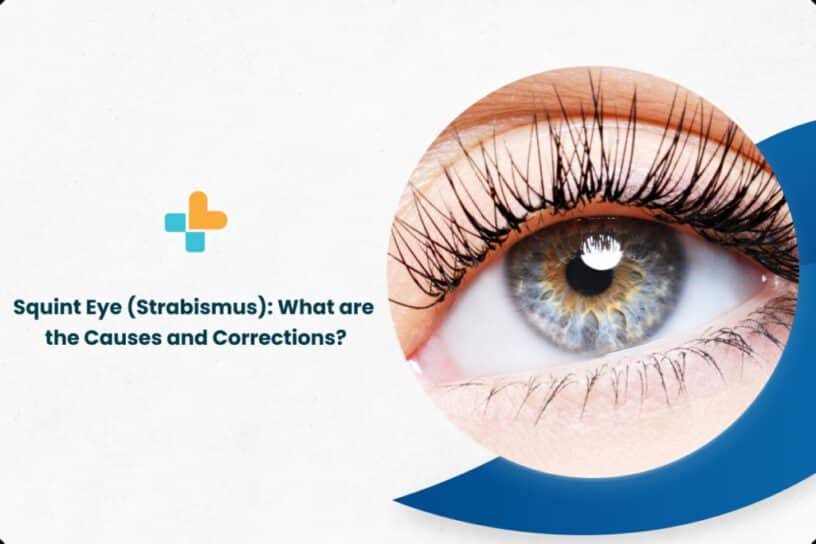What Is Squint?
Squint Eye or Strabismus is a medical condition in which the eyes are misaligned and are pointed in different directions.
What About Childhood Squint?
Some babies are born with squint. In most cases, a squint develops in infancy or early childhood and rarely in an older child (over 5 years of age). Babies tend to have an inward turning of eyes in the first 3 months of life which is completely normal. If the same occurs even after 6 months of age, an assessment must be required.
Causes Of Squint
Common squint eye causes include:
- Refractive errors: Squints can be caused by differences in the refractive power of the eyes, which can cause one eye to focus more effectively than the other.
- Muscle imbalance: The muscles that control the movement of the eye may be out of balance, causing the eyes to misalign.
- Poor vision in one eye: If one eye has poorer vision than the other, the brain may try to compensate by suppressing the image from the weaker eye, leading to a squint.
- Neural problems: Squints can also be caused by problems with the nerves that control the muscles of the eye.
- Other factors: Squints can also be caused by conditions such as premature birth, genetic factors, or head injuries.
When To Consult a Doctor
If you or your child has any of these symptoms, it is important to see a doctor as soon as possible, as squint can affect vision and may require treatment. A doctor can determine the cause of the squint and recommend the appropriate treatment. The symptoms are:
- One eye turns in or out while the other eye looks straight
- Eyes that appear crossed or misaligned
- Difficulty seeing or focusing on objects
- Double vision
- Eyestrain or discomfort when trying to focus on objects
How Can The Squint Be Assessed?
To assess the severity of the condition various squint eye tests are carried out. They are:
- Visual activity test
- Cover test
- Retinoscopy
- Ocular motility test
- Hirschberg Test
Treatment and Surgery For a Squint
Treatment of squint must begin as early as possible for better results. Management of squint in children and adults is different.
Treatment for squint in children may include glasses, eye patches, eye drops, eye exercises, and or surgery. The type of treatment will depend on the cause and severity of the squint. Squint eye surgery involves adjusting the muscles that control the movement of the eyes (extraocular muscles). The goal of the surgery is to realign the eyes and improve vision. Squint procedures produce a perfect cosmetic result.
What Happens After The Operation?
After squint eye surgery, it is common to experience some discomfort and swelling around the eye. You may also have some blurry vision and sensitivity to light. It is important to follow your doctor’s instructions for caring for the eye after surgery, which may include using eye drops, wearing glasses, applying a cold compress, and avoiding certain activities.
In most cases, the recovery period is very short, and you may be able to go home the next day. Most of your routine work can be resumed quickly. In addition, post-treatment care should be adhered to religiously for a fast recovery.
Squint Eye or Strabismus is a medical condition in which the eyes are misaligned and are pointed in different directions.
Some babies are born with a squint. In most cases, a squint develops in infancy or early childhood and rarely in an older child (over 5 years of age). Babies tend to have an inward turning of eyes in the first 3 months of life which is completely normal. If the same occurs even after 6 months of age, an assessment must be required.
To assess the severity of the condition various squint eye tests are carried out. They are:
- Visual activity test
- Cover test
- Retinoscopy
- Ocular motility test
- Hirschberg Test
After squint eye surgery, it is common to experience some discomfort and swelling around the eye. You may also have some blurry vision and sensitivity to light. It is important to follow your doctor’s instructions for caring for the eye after surgery, which may include using eye drops, wearing glasses, applying a cold compress, and avoiding certain activities.
Yes, anaesthesia is generally required for squint surgery. The type of anaesthesia used will depend on the specific procedure being performed and the age of the patient
Local anaesthesia, which numbs a specific area of the body, may be used for some types of squint surgery.
General anaesthesia, which causes a person to lose consciousness during the procedure, may be used for more complex squint surgeries.
The cost of squint eye surgery in India can vary depending on the severity of the squint and the type of surgery required.
In general, the cost of squint eye surgery in India can range from around 50,000 to 1,50,000 INR on a rough estimate.
Squint eye exercises are specific activities designed to improve the alignment of the eyes and strengthen the eye muscles in people with a squint. These exercises may be recommended by an eye care professional as part of a treatment plan for squint.
Some examples of squint eye exercises include:
- 1. Eye patching: Covering one eye for some time to allow the other eye to strengthen and improve its alignment.
- 2. Eye tracking: Following an object with the eyes as it moves horizontally, vertically, or in a circular pattern.
- 3. Focusing on an object at different distances: Looking at an object up close, then at a farther distance, to improve the muscles that control the focus of the eyes.
FAQs
Q1) Is anaesthesia required for squint surgery?
Yes, anaesthesia is generally required for squint surgery. The type of anaesthesia used will depend on the specific procedure being performed and the age of the patient
Local anaesthesia, which numbs a specific area of the body, may be used for some types of squint surgery.
General anaesthesia, which causes a person to lose consciousness during the procedure, may be used for more complex squint surgeries.
Q2) How much does squint eye surgery cost?
The cost of squint eye surgery in India can vary depending on the severity of the squint and the type of surgery required.
In general, the cost of squint eye surgery in India can range from around 50,000 to 1,50,000 INR on a rough estimate.
Q3) What is squint eye exercise?
Squint eye exercises are specific activities designed to improve the alignment of the eyes and strengthen the eye muscles in people with a squint. These exercises may be recommended by an eye care professional as part of a treatment plan for squint.
Some examples of squint eye exercises include:
- Eye patching: Covering one eye for some time to allow the other eye to strengthen and improve its alignment.
- Eye tracking: Following an object with the eyes as it moves horizontally, vertically, or in a circular pattern.
- Focusing on an object at different distances: Looking at an object up close, then at a farther distance, to improve the muscles that control the focus of the eyes.
Conclusion
At Ayu Health, the patients get the best possible healthcare at affordable prices. Having an excellent team of doctors and healthcare professionals, it’s undoubtedly the best option for anybody. Are you looking for a good ophthalmologist to consult? Contact us at 636-610-0800 to know more.
Our Hospital Locations
Ophthalmology Surgery Hospitals in Chandigarh | Ophthalmology Surgery Hospitals in Bangalore | Ophthalmology Surgery Hospitals in Jaipur | Ophthalmology Surgery Hospitals in NCR | Ophthalmology Surgery Hospitals in Hyderabad
Our Doctors
Ophthalmology Surgery Doctors in Chandigarh | Ophthalmology Surgery Doctors in Bangalore | Ophthalmology Surgery Doctors in Jaipur | Ophthalmology Surgery Doctors in NCR | Ophthalmology Surgery Doctors in Hyderabad




